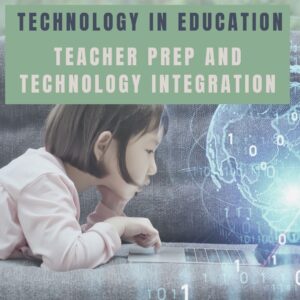We know technology is a challenge for veteran teachers. It wasn’t part of their teacher training program so they rely on school PD to fill the many holes in blending tech with education. What is surprising is that many teacher programs don’t prepare their graduates well for the rigors of using technology to meet current educational requirements. That is made worse by the demands of a post-pandemic classroom that often operates online, remotely, or a hybrid. Ask a Tech Teacher contributor, Christian Miraglia, 35 years as a teacher and now an educational consultant for T4Edtech, has a good discussion on that:
 For many years I served as a master-teacher for prospective teachers from various universities in my area. In my interactions with the candidates, I found that although their coursework focused on methodology and practice, it invariably lacked a technology integration component. It was clear that as I worked with these up-and-coming teachers, their first exposure to the integration of technology was in my classroom. I can only imagine a teacher entering the workforce now who has to contend with the basics of teaching and then realizes that there is a whole other component of the equation that they were inadequately prepared.
For many years I served as a master-teacher for prospective teachers from various universities in my area. In my interactions with the candidates, I found that although their coursework focused on methodology and practice, it invariably lacked a technology integration component. It was clear that as I worked with these up-and-coming teachers, their first exposure to the integration of technology was in my classroom. I can only imagine a teacher entering the workforce now who has to contend with the basics of teaching and then realizes that there is a whole other component of the equation that they were inadequately prepared.
In the report, Reimagining the Role of Technology in Education, published in 2017, the Office of Technology Education recommended that:
“Institutions responsible for pre-service and in-service professional development for educators should focus explicitly on ensuring all educators are capable of selecting, evaluating, and using appropriate technologies and resources to create experiences that advance student engagement and learning. They also should pay special care to ensure that educators understand the privacy and security concerns associated with technology. Institutions cannot achieve the goal without incorporating technology-based learning into the programs themselves.”
And here lies the problem. The pandemic affected every school district in the nation, yet many of the university programs still lack the technology component in their programs three years later. Exposed now are deficiencies of utilizing online learning management systems that school districts face. There should be a concerted effort to focus on this area.
Moreover, sending teachers into the workforce without adequate training is equivalent to sending doctors out to practice without learning to treat specific ailments. The student today learns much differently than students did five years ago. Moreover, the general use of technology has changed. There is an increased movement towards personalizing the educational experience, practiced with student agency and choice on assessments. For a teacher, this translates into knowing what students use and understanding these platforms themselves.
Here is an excerpt from the publication K-12 Dive recent piece on pandemic learning.
“According to the survey results, conducted in March, 74% of teacher respondents were in a fully remote or hybrid teaching model at the time, and 58% had no prior online teaching experience. Nearly all respondents used some kind of video instruction during the pandemic.”
Without a doubt, the indicators of this study demonstrate that teachers need assistance. The study does not account for the level of experience of the teachers. Still, knowing that many educators retired at the end of the past school year, I can imagine that on a larger scale, those entering the workforce face unprecedented challenges such as course design and managing an online platform.
A few university programs such as Susquehanna University have incorporated a technology component that focuses on pedagogy and best practices adopting some of the latest integrations into classroom curriculum. Additionally, ISTE provides opportunities such as the Online Learning Academy and literature targeting new teachers, such as the 2020 publication
4 Action Steps to Prepare New Teachers to Use Edtech. Despite these efforts, there is a need for a paradigm shift in the preparation of new teachers. Adopting successful models of technology integration such as those utilized at George Mason University’s Elementary Education Program is a start. Much like those completing medicine studies where the clinical approach is the cornerstone, GMU’s strategy is to work with a partner school evaluating how technology is integrated and then work with prospective candidates with the implementation process. More information on their program and teacher preparation is found in the book Championing Technology Infusion in Teacher Preparation, edited by Arlene Borthwick, Teresa S. Fougler, and Kevin J. Graziano.
Each week as increasingly more stories enter the news cycle; it is clear that both new and veteran teachers need guidance in technology integration. The age-old question is how much the states and the federal government will invest in the cause? Our student’s future depends on it.
Bio
Christian Miraglia is a recently retired 36 year educator and now Educational Technology Consultant at t4edtech where he also blogs. He can be found on Twitter @T4edtech and on his YouTube Channel Transformative Edtech.
@T4Edtech #edtech
Jacqui Murray has been teaching K-18 technology for 30 years. She is the editor/author of over a hundred tech ed resources including a K-12 technology curriculum, K-8 keyboard curriculum, K-8 Digital Citizenship curriculum. She is an adjunct professor in tech ed, Master Teacher, webmaster for four blogs, an Amazon Vine Voice, freelance journalist on tech ed topics, contributor to NEA Today, and author of the tech thrillers, To Hunt a Sub and Twenty-four Days. You can find her resources at Structured Learning.




































